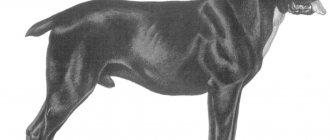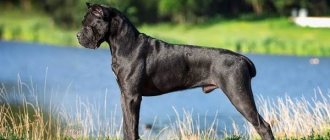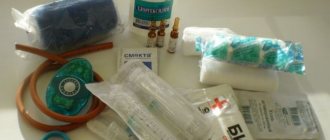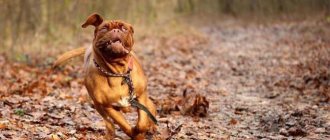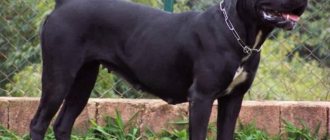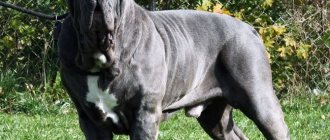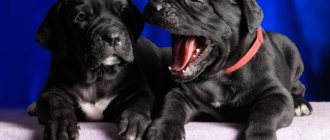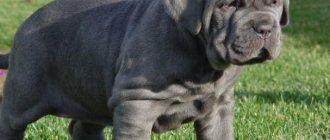The Neapolitan Mastiff is one of the largest dog breeds. This massive dog is considered an ideal guard, a loyal and devoted family friend. The breed has significant maintenance and care features that are important to consider before purchasing a puppy.
Varieties of colors
The breed standard allows the following types of colors.
Preferred:
- grey;
- lead gray;
- black;
- brown;
- pale yellow;
- dark fawn (red fawn).
Small white patches on the chest and/or toes are acceptable. All of these colors can be brindle.
Acceptable colors:
- walnut;
- gray-blue;
- Isabella shades.
Appearance of the dog
The large creature, with an average height at the withers of 76 cm and a weight of 86 kg, has a proportional build; the female sex is more graceful and light.
- The head is square in shape with pronounced muscles on the cheeks, temples, and crown.
- The skull is smoothly contoured with a smoothed occipital protuberance.
- The muzzle is rectangular in shape, with folds appearing in the middle of the frontal part when concentrating or alert.
- A flattened black nose with wide open nostrils.
Lips have a fleshy structure. The thin, drooping ears are set high and set back to the sides, have a triangle configuration and are rounded at the tips. The eyes are low and wide, with a hazel-colored iris.
There is a sense of good nature in his gaze due to the characteristic “glasses”. Jaws with a scissor or level bite; when the mouth is closed, the white teeth are practically invisible. The neck is slightly elongated, the skin on the throat is folded in symmetrical folds.
Powerful and elongated body with a chest dropped to the elbows. The abdomen and groin are tightened. The tail, in the shape of a sickle, is lowered in a calm state, and when moving it reaches the dorsal level. Round pads of strong limbs with gathered toes. The short, coarse coat has a dense undercoat. Photos of the English Mastiff demonstrate that its coat has:
- brindle;
- Silver;
- Apricot;
- Yellowish brown;
- Fawn color.
An indispensable feature is a black “mask” on the face and ears.
Origin story
The ancestors of mastiffs are the oldest Molossian dogs . The oldest mentions of them date back to the 5th century BC, when powerful dogs were part of the troops of the Persian king Xerxes. On the bas-reliefs of that time, Molossians are depicted in armor. Their size can be judged by the warriors standing next to the dogs. The size of the dogs is impressive. Of course, there was no talk of any breeding work in those days, and Molossians were crossed with different dogs. Mastiffs are the result of such crossing.
Image of ancient Molossians
Statues and bas-reliefs depicting mastiffs were found in India, Persia, Nineveh, and Etruria. Dogs took part in wars, dog fights, and gladiatorial fights with animals - usually bulls and bears.
Altair
I'm Altair, the site's mascot!
Ask a Question
The name of the breed comes from the Latin word “massivius”, which means “large”, “massive”. A fitting name for giants. "Neapolitano" is a reference to Naples, the Italian city where many mastiffs ended up after the collapse of the Roman Empire.
The British tribes used mastiffs in battles with the Roman legions . And in the war against the Persians, Alexander the Great already sent about fifty mastiffs into battle.
Mastinos were also used in peaceful life: guarding livestock, property and hunting were well suited to impressive animals. After the collapse of the Roman Empire, most of the breed ended up in Naples, where they mixed with Iberian Mastino.
For many centuries, mastiffs lived alongside people. By the 20th century, lack of control and chaotic crossing brought the breed to the brink of extinction. The Second World War also contributed to the decrease in the number of mastino. Most likely, they faced the fate of the Molossians, who did not survive as a breed, but gave rise to several new types of dogs.
The few mastiffs that remained alive took part in exhibitions. But the exterior, character, and working qualities of the dogs were very different. More and more often, doubts arose that purebred representatives of the breed still existed. In 1946, a group of Italian breeders set out to restore the breed . Professor Solaro delved into the study of mastiffs.
In 1946, at an exhibition in Naples, writer, journalist and dog handler Piero Scanziani saw a group of eight mastiffs participating in a non-competition show. A blue male named Guaglione captivated the writer, and he joined the development of a new breed standard to replace the outdated one created by Dr. Durante.
Piero Scanziani
Brief biography of the breeder
Piero Scanziani
Years of life: 1908-2003. Swiss-Italian writer. Author of books translated into several languages. He has received numerous literary awards, including the Schiller Prize for all his work in 1997, and was twice nominated for the Nobel Prize in Literature in 1986 and 1987. After the war he helped restore the Neapolitan Mastiff breed. When he first saw a mastiff at an exhibition in Naples in 1946, he wrote: “I recognized him at once, he was one of the hundred that the Macedonian Paolo Emilio brought to Rome in his triumph, he was the great dog of Epirus... from the height of his centuries he looked looks at me calmly, the eyes are not hostile and unkind, a look that does not give or ask, it looks (...) "
The document, released in 1949, did not take into account the physical and service characteristics of the breed, so it was supplemented for several years. Scanziani found several more purebred mastiffs for his kennel. The offspring of these dogs were distinguished by outstanding qualities and repeatedly won championship titles in the future. Also in 1946, the breed was recognized by the Italian Kennel Club.
The most accurately describing the Neapolitan Mastino standard was created in 1961 by a group of dog handlers: Soldati, Conti and Cagelli. To do this, they studied and measured many dogs.
In the New World, the first representative of the Neapolitan Mastino was officially registered in 1973, and the Neapolitan Mastiff Association in the United States was created in the 1990s.
The latest changes to the standard date back to 2015. The breed is considered Italian. Recognized by the International Canine Federation and other international organizations. Now Neapolitans perform the functions of watchmen, security guards, companions, and search dogs .
Training
Early socialization is required to prevent aggressive habits. Parenting is done in childhood, teaching the baby to be the leader of the owner.
- They tame obstinacy with tenderness and affection, encouragement with tidbits, trying to earn trust.
- Raising your voice or physical impact is unacceptable; only patience and love can achieve positive results.
- Training takes place for an hour with reinforcement of the material covered.
- The breed is characterized by slowness and passivity; orders are executed after deliberation.
You should not force your pet to repeat it repeatedly for personal pleasure; an intellectual will not want to be a puppet even in the master’s hands.
Mentions of Mastino Neapolitan
Movies
In the Harry Potter films, Hagrid's dog, Fang, was played by Mastino Neapolitan.
Famous representatives of the breed: myths and reality
There is very widespread information on the Internet about the Neapolitan mastiff Hercules, which was listed in the Guinness Book of Records as the largest dog weighing 128 kg. True, such a record could not be found on The Guinness World Records website, and some sources also claim that the photo of the dog is fake, since the size of the dog in the photo is slightly smaller than the size of a horse.
Neapolitan Mastiff
But the dog Hercules really existed, only he was an English mastiff whose owner was named John Flynn from Peabody, Massachusetts. And the dog's weight was 282 pounds (128 kg).
English Mastiff Hercules
There is a record of Mastino as the largest puppies, it dates back to 2004, and the babies were born in England.
How to choose a puppy
To be sure that this is really a Neapolitan mastiff, it is better to buy it in a specialized nursery.
This way there is less chance that you will be given a low-breed specimen.
It is best to go on a first date with a puppy when the baby is between 45 and 60 days old, and to wean it from its mother after two months.
When choosing a dog, you should pay attention to the following points:
- Mastiffs often suffer from hip dysplasia. Check the puppy's hindquarters.
- The baby's parents must be kept in good conditions and be absolutely healthy.
The Mastiff becomes very close to the family in which he lives. Sometimes this devotion is fraught with excessive jealousy
Decide in advance why you are buying a dog. All breeds are divided into three classes: breed, show and pet class.
The breed class is impeccable in health and appearance; such dogs are intended for breeding offspring.
The show class consists of highly qualified participants and winners of various exhibitions.
The pet class is not suitable for breeding and exhibitions; it is the so-called second grade.
Often, such puppies have minor flaws that will be noticeable during professional activities, but are completely leveled out at home.
The cost of the latest puppies is much less than show and breeding class.
The Neapolitan Mastiff, whose price ranges from 400 to 1,500 USD, is not a cheap pleasure.
The Neapolitan Mastiff is a large dog that needs a lot of space to live comfortably.
Breeds similar to Mastino Neapolitan
It is quite difficult to confuse this powerful giant with its large folds on its muzzle. The pictures show several breeds that have similar features. These similarities can be found in many breeds that are classified as Molosser types.
Neapolitan Mastiff VS Dogue de Bordeaux
Mastino Neapolitan VS Fila Brasileiro
Mastino VS Cane Corso
Nutrition
Impressive dimensions mean food consumption in kilograms, which will cost the breeder a pretty penny.
- The main thing is not to combine dry food and natural products, choosing one.
- In the second case, you cannot feed milk, tubular bones, mushrooms and river fish, fatty pork and smoked meats.
- Be sure to enrich the diet with vitamin and mineral supplements.
- The babies eat 5 times a day, and are gradually transferred to twice a day feeding.
- There should always be fresh, unboiled water in the bowl.
Character and habits
Frightening appearance and reverent attitude towards the owner. It’s not for nothing that Mastinos are called “gentle giants.” A person whom a Neapolitan recognizes as a master can count on absolute loyalty, understanding, obedience and strong friendship.
Character Traits of Boys and Girls
The main character traits of the Mastino of both sexes are similar.
- ♀︎ Girls are characterized by more pronounced jealousy and mood swings due to hormonal processes, but they are also more affectionate than boys.
- ♂︎ Boys are more likely to have dominant leadership qualities and may be more willful.
Friendliness
Once in the family, the Neapolitan Mastino determines the leader and gives him all the love, devotion and friendship . The rest of the family, along with other pleasant things like a sofa, are considered the owner's property. Mastino takes on certain responsibilities in relation to his household:
- Don't offend.
- Protect.
And the dog performs these duties honestly. It’s hard to imagine a friendlier and more caring pet towards “their own” .
You can't always say that about guests. If they do not pass the “friend or foe” response, then the Mastino will be extremely suspicious of new friends and distant relatives. Representatives of the breed are jealous, and attention not given to them is a personal insult. If a visitor often appears in the house, does not threaten his beloved owner, and the dog is not forgotten during the visit, the Neapolitan Mastiff recognizes the guest as “one of his own.”
Strangers will get a warm welcome from the mastiff. If there is no direct threat to the owner or property, you don’t have to wait for the giant’s attack . But the appearance alone is enough to discourage a repeat visit. Mastino will probably try to get closer, driven by suspicion. If the visitor has a weak nervous system, a loud voice and sudden movements, everything can end badly.
The Neapolitan's jealousy also serves as a bad service in the case of other domestic animals. The “Gentle Giant” is sensitive to the owner’s attention and may try to eliminate a competitor. Other animals, such as cats, are usually of little interest and may well become friends, especially if they grow up together.
Expert commentary
Suvorova (Stanis) Helen
I am a practicing veterinarian and an expert on the Zoovlog.ru project
Ask a Question
Males will build hierarchical relationships among themselves during puberty. There must be a leader in a pack and this is the law in the dog world.
The possessive feeling does not extend to the animals you meet during a walk. The Mastiff is sufficiently fascinated by new places and smells to not pay attention to the dogs and cats he meets. If they do not express aggression towards the owner, of course.
Attitude towards children
Mastino Neapolitan will enjoy spending time with children . He will not offend “human puppies”. It’s fun for him, and the children are happy with the big, warm, live “horse.” But you shouldn’t leave the giant alone with a small child: the grace and agility of the mastiff leave much to be desired. An accidental push or tail hit from a powerful dog can lead to serious injuries.
Security qualities
The Neapolitan watchman is excellent. This dog has a great sense of ownership. The mastiff will perform guard duties zealously.
Representatives of the breed are silent, and deal with border violators on their own. In most cases, it is enough to simply appear to the attacker, and this will end the penetration attempt. The mastiff will only decide to attack if the intruder has ignored all warnings.
The Neapolitan is also good as a bodyguard. The protective instinct is well developed. He reacts to a threat to the owner or household members with lightning speed . There is no trace left of the apparent sluggishness and clumsiness. A high-speed dash - and the giant shields “his” people with his chest. In such cases, the Mastino does not bark or warn, but immediately attacks.
Psychology
The Neapolitan Mastiff, photos of which can often be found on the Internet, is a born watchdog.
His sedate and measured character, combined with a strong and muscular body, makes this dog an excellent guard.
- Friendliness. Despite its menacing appearance, the Neapolitan Mastiff is an affectionate and gentle dog. He loves human company and gets along well with children and pets. It is often compared to a bullmastiff .
- Devotion. The Mastiff becomes very close to the family in which he lives. Sometimes this devotion is fraught with excessive jealousy.
- Equilibrium. The Neapolitan Mastiff does not suffer from unreasonable bouts of aggression; it is a reasonable dog that, if properly trained, will behave calmly. The Beauceron breed has similar features .
The size of the mastiff sometimes plays a cruel joke on the dog: he is too lazy to move around and do active exercises. The Neapolitan Mastiff dog is often obese.
- Defender. For a Neapolitan, the owner is a king and God who needs to be protected and protected. He will not allow anyone to hurt you and will always come to the rescue.
- Laziness. The size of the mastiff sometimes plays a cruel joke on the dog: he is too lazy to move around and do active exercises. The Neapolitan Mastiff dog is often obese.
Important! Do not leave small children unattended around your Mastiff. A dog while playing, without meaning to, can harm the baby. It’s all to blame for her sluggishness and slowness.
- The need for socialization. This breed is characterized by traits such as stubbornness and shyness. From an early age they need to be taught to communicate with people and animals - socialized.
- Sloppiness. If you are ready for drooling and snot all over the house, don’t get tired of collecting food that is carried around the rooms, don’t regret an accidentally broken vase that was touched by a clumsy mastiff - the Neapolitan can become your favorite.
The Neapolitan Mastiff does not suffer from unreasonable bouts of aggression; it is a reasonable dog that, if properly trained, will behave calmly
Poll: What is your Neapolitan Mastiff like?
Obedience
He listens to me, there is no problem with that.
16.67%
Doesn't always follow commands, especially if he doesn't consider them particularly interesting.
50%
An independent and willful dog, he has serious problems with obedience.
33.33%
Voted: 6
Temperament
Calm disposition, one might even say phlegmatic. We prefer the sofa to be active.
0%
Active outside, at home he collapses on the sofa/bed and falls asleep.
40%
Probably, when calmness was distributed, my dog stood in line for activity along with the Aussie.
60%
Voted: 5
Friendliness
He loves only me, he accepts others with calm in his eyes.
20%
Loves the whole family, we spend a lot of time together. Wary of strangers.
80%
This loving giant is ready to hug anyone and everyone.
0%
Voted: 5
Protective and security qualities
He protects both me and his territory.
42.11%
It may begin to bark when strangers approach, but this is where the protection ends.
36.84%
Safety and security is not about us.
21.05%
Voted: 19
Grooming activities
Short fur will require minimal care; it is brushed with a bristle brush three times a week, although shedding will force you to do this procedure more often. Bath as needed with a special product. After the bath, avoid drafts, which can lead to a cold.
Clean owners and aesthetes will probably not be able to come to terms with the presence of:
- Excessive salivation;
- Sloppy eating habits;
- Loud snoring;
- Flatulence;
The face and the wrinkles present on it must be cleaned regularly with a damp cloth. Wipe the ears and eyes, brushing the teeth is necessary, especially the back ones to preserve the enamel. Hot weather is not suitable for going outside; due to the brachycephalic type of “face”, breathing becomes difficult.
Pros and cons of mastino
Dogs always have more advantages than disadvantages. Many bad sides appear due to improper or insufficient education or attention to the dog. There are several characteristics that can be classified as positive or negative characteristics of the breed.
Advantages and disadvantages
Boundless devotion to the owner
Love for children
Protective and security qualities
Drooling
High cost of maintenance
Education and training
We can talk a lot about the friendliness and calmness of mastiffs, but this does not negate the need for socialization and training in manners.
Lack of proper education and discipline leads to the fact that a huge dog becomes uncontrollable and aggressive.
Socialization is necessary as early as possible . The guard breed must realize that not all strangers are enemies. During socialization, the dog gets acquainted with the world around him and learns to react correctly to events. The owner's calm and confidence are important in the process.
When training, it is important to remember that the Mastino Neapolitan is ready to do anything to please the owner. But his reaction to commands is slow. The animal thinks about the command before executing it.
Novash (Novas) Elena
Editor-in-Chief of the site, yoga instructor and big animal lover
Ask a Question
Initially, the little Mastino is taught to use a leash, and he remembers his name. During the classes we learn simple commands that help control the dog: “Come to me”, “Nearby”, “No”.
A favorite treat or praise will be an excellent positive motivation. But the use of physical force to punish or overcome a pet’s stubbornness is unacceptable . Mastino becomes embittered and remembers that the owner caused the unpleasant sensations. Considering the size of the dog, this is unsafe. The training process should take place in a calm manner; if you do not have enough patience or experience for this, it is better to contact a professional dog handler.
Prohibitions must be observed by all family members. If one scolds and the other praises the dog for the same action, it is difficult for the animal to figure out what to do.
A general training course (GTC) can begin at six months of age. When choosing a trainer, it is better to give preference to those who have already worked with this breed. And only after complete obedience has been achieved, can you undergo protective guard service (PSS). It will give the mastino an understanding in which cases it is necessary to show aggression and in which it is not, and will help him act more effectively.
Health
Characteristic diseases
In general, the Neapolitan Mastiff is a healthy dog, but the manifestation of predisposed diseases depends on proper nutrition and living conditions.
Neapolitans may suffer from:
- hip dysplasia;
- elbow dysplasia;
- cardiomyopathy;
- demodicosis;
- dermatitis;
- entropy;
- progressive retinal atrophy;
- hypothyroidism;
- cardiomyopathy;
- pyoderma.
More information about demodicosis in dogs:
According to the level of training, the Neapolitan Mastiff is a good dog. He remembers commands perfectly, but is in no hurry to carry them out. Long and monotonous repetitions of exercises tire him
Vaccinations
The Neapolitan Mastiff dog needs high-quality protection from various diseases.
To keep your pet safe, it is important to follow the vaccination .
At two months, the puppy must receive its first vaccination and repeat vaccinations as prescribed by the doctor.
This breed is characterized by traits such as stubbornness and shyness. From an early age they need to be taught to communicate with people and animals - socialized
Is it possible to keep in an apartment?
Since the Mastino Neapolitan is a very large dog, the space for keeping it should be spacious. In small apartments the pet will be cramped. In addition, during games it can cause damage to furniture. You will also have to come to terms with the profuse salivation that occurs periodically in this breed.
Arrangement of a resting place
Mastiff (dog): what types of breed are there?
The room where the pet lives should be large. It is undesirable for it to be damp and too stuffy. For a healthy rest, purchase a soft mat or lounger.
Note! The surface of the lying area should not be hard. Otherwise, calluses and corns will form on the dog’s body. If the dog lives in the yard, then a spacious enclosure with soft bedding is needed.
Walking and physical activity
Every day you need to walk your dog for about 2-3 hours. During the walk, the pet explores the surrounding area and gets to know other dogs. During this period, the owner can play with the dog or teach commands. Long-term walking ensures the full development of the muscular system.
Best places to walk:
- forest;
- River bank;
- a park;
- meadows
Important! During walks, you need to make sure that the mastiff does not get heatstroke. In summer, it is preferable for the dog to be in the shade and have constant access to water.
